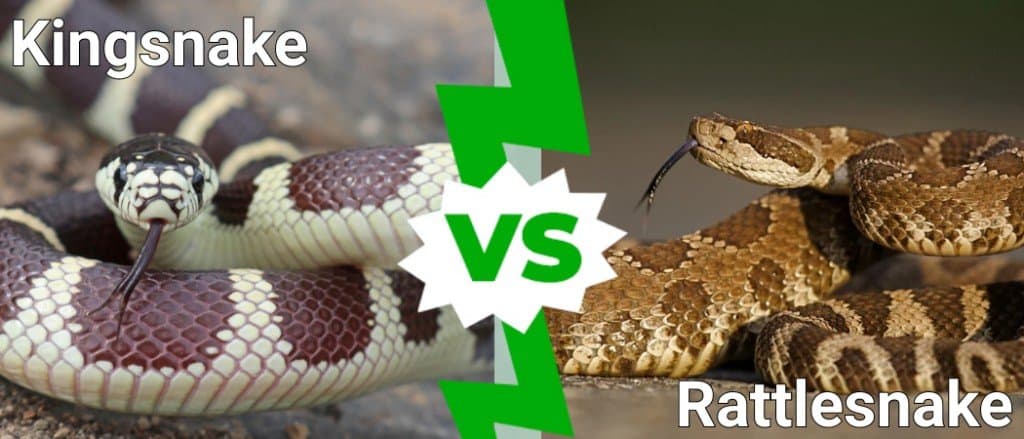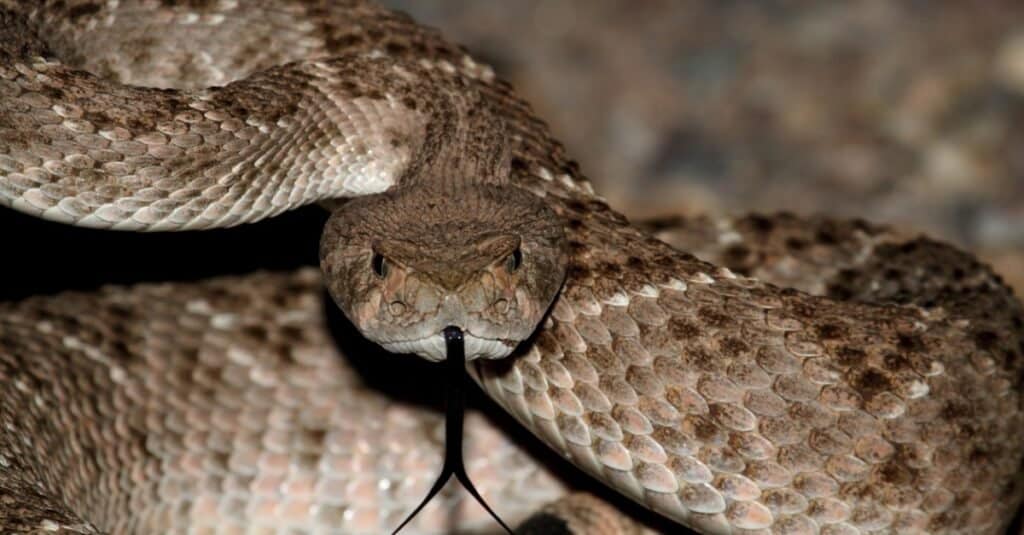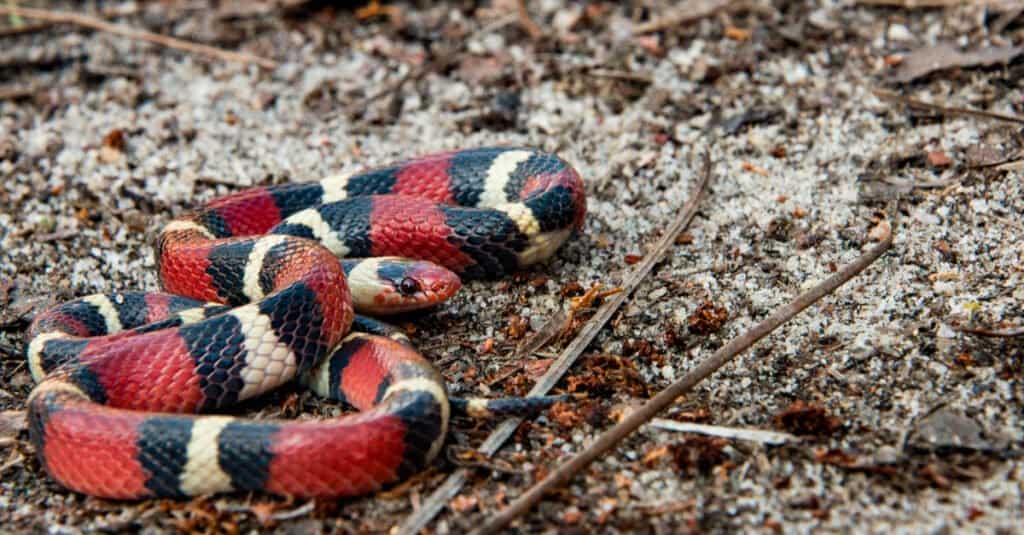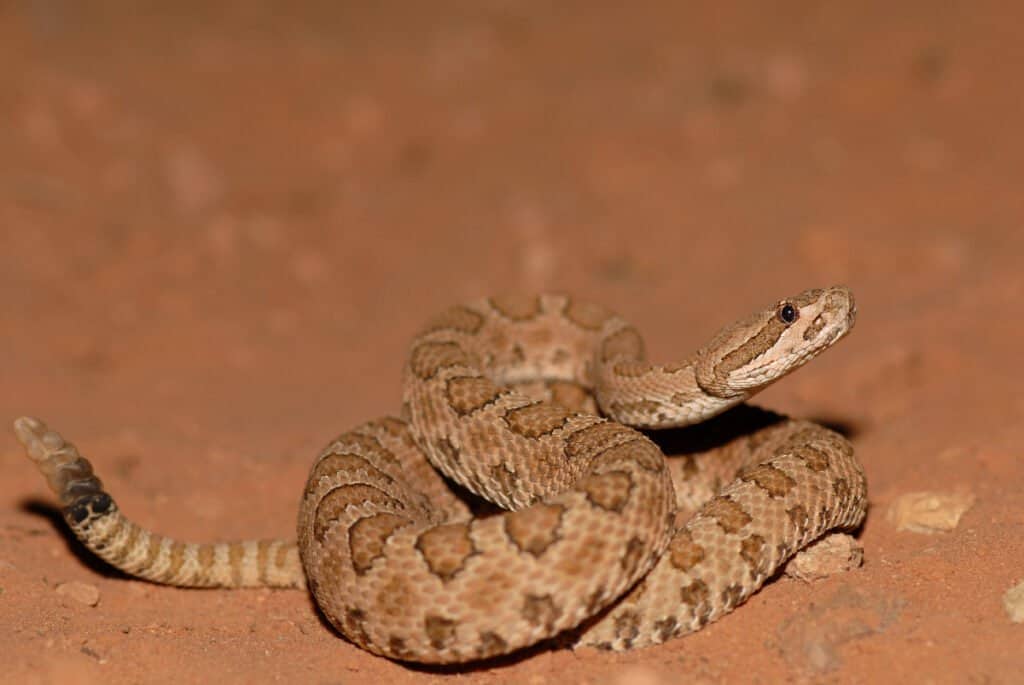Kingsnakes vs rattlesnakes are two different species of snakes that can be compared in many ways. However, there are many key differences between these two types of snakes that distinguish them from one another. The rattlesnake is from the Crotalus genus of pit vipers, while the kingsnake is from the Lampropeltis genus.
While kingsnakes and rattlesnakes live in similar environments and are often found in the same location with one another, they have many differences that separate them from each other. Their appearances are very different, as well as the way in which they kill and consume their prey. What other differences might these two snakes have? Let’s learn more about them now.
Comparing Kingsnakes vs Rattlesnakes

| Kingsnake | Rattlesnake |
|---|---|
| Venomous? No | Yes |
| Size 2-7 feet; skinny | 2-7 feet; medium build |
| Color Red, black, yellow, green, and white | Shades of brown, black, and even pink or gold |
| Habitat Dry deserts and humid forests in North America | Dry deserts, forests in North America and Mexico |
| Markings Distinct stripes in different colors | Distinct diamond or blotchy pattern |
| Eggs Yes | No (live birth only) |
The 6 Key Differences Between Kingsnake vs Rattlesnake
There are key differences that separate kingsnakes vs rattlesnakes. Kingsnakes are non-venomous and relatively harmless snakes found in dry deserts or humid forests, depending on the specific species. Rattlesnakes are venomous and known for their distinctive rattling tail — they also live in many different habitats. Rattlesnakes also give birth to live young, while kingsnakes lay eggs like many other varieties of snake.
Let’s dive in and learn more about the specific differences between these two snake species.

Rattlesnakes have venomous snake features, while kingsnakes are often known for their slender and rounded heads, and round pupils.
©iStock.com/SteveByland
Kingsnake vs Rattlesnake: Markings and Coloring
One of the main differences between kingsnakes and rattlesnakes is their markings and coloring. Kingsnakes are well known for their bright and vivid colors, often in red, yellow, white, and black. Their skin is often banded, with each band repeating in the same color pattern, some species have speckles or spots.
In contrast, rattlesnakes typically have a blotched pattern and heavily keeled scales. Keels are ridges on each scale that make rattlesnakes look rough. Rattlesnakes are also usually a duller color than kingsnakes, ranging from dusty brown to light gold or pink. Given their more muted color palette, they are easily distinguished from kingsnakes.

Rattlesnakes give birth to live young, while kingsnakes lay eggs like many other varieties of snake.
©Creeping Things/Shutterstock.com
Kingsnake vs Rattlesnake: Preferred Prey
Another distinguishing feature between kingsnakes and rattlesnakes is the way in which they kill their prey and the prey that they choose to consume. Kingsnakes are non-venomous and therefore must use constriction in order to kill their prey. Rattlesnakes have the advantage over kingsnakes in that they can use their powerful venom to incapacitate their meals.
Rattlesnakes and kingsnakes prefer to eat rodents and other small mammals whole as part of their diets. However, kingsnakes are called kingsnakes because they are known for consuming other species of snakes. They have even been known to attack and eat rattlesnakes, which is a huge difference between a rattlesnake’s typical diet.
Kingsnake vs Rattlesnake: Venom
Kingsnakes and rattlesnakes are different from one another in that kingsnakes are non-venomous and rattlesnakes are venomous. This isn’t something that you can necessarily tell by looking at them, but it is an important distinction when it comes to telling them apart. While any snake bite will be painful, it would be better to be bitten by a kingsnake than by a rattlesnake!

Kingsnake skin is uniquely striped, with each band repeating in the same color pattern; rattlesnakes also have a pattern on their skin, but they are usually not stripes.
©Jay Ondreicka/Shutterstock.com
Kingsnake vs Rattlesnake: Pupils and Head Shape
A distinguishing physical feature between kingsnakes and rattlesnakes is their head shapes and pupil shapes. Venomous snakes are often characterized by their narrow and vertical pupils, along with their triangle-shaped heads. Rattlesnakes have these features, while kingsnakes are often known for their slender and rounded heads, and round pupils. This is because they are a non-venomous snake species.
While it can be dangerous to observe a snake from close up, pupils are an easy way of telling venomous and non-venomous snakes apart. Kingsnakes usually have smaller and round heads when compared to rattlesnakes, and they also will not have pits on their face. Rattlesnakes use pits to sense prey when hunting at night, as pits allow them to sense detailed temperature changes.
Kingsnake vs Rattlesnake: Eggs
Another difference between kingsnakes vs rattlesnakes is the way in which they birth their young. Rattlesnakes are capable of giving birth to live young, which is not a typical kingsnake characteristic. Most vipers give birth to live young, but kingsnakes are not vipers. They lay eggs, like many other species of snake.

A distinguishing physical feature between kingsnakes and rattlesnakes is their head shapes and pupil shapes.
©Rusty Dodson/Shutterstock.com
Kingsnake vs Rattlesnake: Rattle
The final and potentially most obvious difference between kingsnakes and rattlesnakes is the presence of a rattle at the end of the snake’s tail. This is a trademark rattlesnake characteristic, and it will not be found on any non-venomous snakes, including kingsnakes. Kingsnake tails end in a pointed tip, while rattlesnake tails end in a bulbous rattle. Even young rattlesnakes who haven’t fully developed will have the beginnings of a rattle forming!
The photo featured at the top of this post is © Creeping Things/Shutterstock.com
Discover the "Monster" Snake 5X Bigger than an Anaconda
Every day A-Z Animals sends out some of the most incredible facts in the world from our free newsletter. Want to discover the 10 most beautiful snakes in the world, a "snake island" where you're never more than 3 feet from danger, or a "monster" snake 5X larger than an anaconda? Then sign up right now and you'll start receiving our daily newsletter absolutely free.
Thank you for reading! Have some feedback for us? Contact the AZ Animals editorial team.






